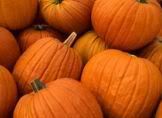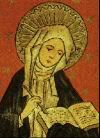Tuesday, October 24, 2006
Halloween: All Hallows' Eve All Hallows' Eve, otherwise called "Halloween", is the eve of the feast of All Saints Day. It is hard to believe that such a secularized holiday that is now associated with black cats, haunted houses, and such is actually, in it's roots, a Christian celebration. "Halloween" is "All-Hallows'-Eve."
All Hallows' Eve, otherwise called "Halloween", is the eve of the feast of All Saints Day. It is hard to believe that such a secularized holiday that is now associated with black cats, haunted houses, and such is actually, in it's roots, a Christian celebration. "Halloween" is "All-Hallows'-Eve."In her book, The Year and our Children, Mary Reed Newland writes about Halloween, providing historical information as well as delighful ideas on how to celebrate. You can read her section on All Hallows Eve here. The whole book is worth picking up... I couldn't put it down. (Now it's in a box somewhere, and I'm frustrated that I don't have it on-hand with all the holidays coming up.) I'm going to quote quite a bit from this book, as it's so interesting and informative. She reminds us that All-Hallow's Eve happens* to fall during the same time of year in which numerous cultures celebrated the end of the harvest season:
~"A celebration much like our Halloween, with bonfires and feasting on apples and nuts and harvest fruits, was part of pagan worship for centuries. The Britons celebrated in honor of their sun-god with bonfires, a tribute to the light that brought them abundant harvest..." She goes on to say this:
~*"Whether the Church 'baptized' these customs or chose this season for her feasts of the dead independent of them, their coincidence shows again how alike men are when they seek God and His ways, give praise, use the language of symbols to express the inexpressible." (I thought that this was quite a good point.)
~"It was in the eighth century that the Church appointed a special date for the feast of All Saints, followed by a day in honor of her soon-to-be saints, the feast of All Souls. She chose this time of year, it is supposed, because in her part of the world it was the time of barrenness on the earth. The harvest was in, the summer done, the world brown and drab and mindful of death. Snow had not yet descended to comfort and hide the bony trees or blackened fields; so with little effort man could look about and see a meditation on death and life hereafter."
~"It was in Ireland and Scotland and England that All Hallows' Eve became a combination of prayer and merriment. "
 So where does Trick-Or-Treating come from? So many people think that trick-or-treating is not appropriate and a purely secular aspect of this eve. As I loved the merry aspects of trick-or-treating a child (not the horrifying ones, of course!) I was thrilled to hear the following:
So where does Trick-Or-Treating come from? So many people think that trick-or-treating is not appropriate and a purely secular aspect of this eve. As I loved the merry aspects of trick-or-treating a child (not the horrifying ones, of course!) I was thrilled to hear the following:"Begging at the door grew from an ancient English custom of knocking at doors to beg for a 'soul cake' in return for which the beggars promised to pray for the dead of the household. " !!! ("Soul, soul, an apple or two,If you haven't an apple, a pear will do,One for Peter, two for Paul,Three for the Man Who made us all...")
"The familiar harvest fruits, cornstalks, and pumpkins were seasonal"... But what about the Jack-o-lanterns?
"These were ages when death was a serious and acceptable meditation. Christian art shows skulls and bones as a commonplace of interior decoration, at least in the cells of the convents and monasteries. Vigils were kept by the graves, and lights and bread left for the dead, all for the twofold purpose of recalling those dead and remembering that one day you would be dead. Surely it was some bright boy, stumbling over a pile of pumpkins by his father's barn, who hit on the notion of carving a grinning death's-head to carry, lighted by a candle, under his arm. If you know small boys, this is the most reasonable of all explanations..."

We learn from all this that most of the basic parts of Halloween are in fact part of Christian traditions on the eve of the Feast of All Saints Day. We celebrate and remember the reality of life and death, rejoicing in the summer's harvest, and such.
"Our family's Halloween parties are now planned around the custom of begging for soul cakes...Frying doughnuts is a big undertaking, but this one time of the year we have a doughnut session — the day before Halloween. Soul cakes need not be doughnuts..."
I don't know about you, but all of this makes me so excited about starting my own traditions for this eve. At a certain time in my life I really couldn't stand Halloween and stayed away from it all like the plague. I stil do stay away from the parts of this holiday that are obviously bad for your mental and spiritual health, such as terrifying haunted houses and so on. But the merry aspects of Halloween are now more full of light to me, such as dressing up and trick-or-treating. These can be wholesome activities made very meaningful to our children if it is all in keeping with what the holiday (feast day) is really all about.
I hope to have an annual All Hallows' Eve party some day, celebrating the harvest and the Saints. Decorations could be jack-o-lanterns, dried corn stalks, etc. Perhaps our children and the children who come over can all dress up as Saints and we can have a parade and a guessing game time where the adults all guess, by the child's dress/costume, which saint each child is. We could do activities such as apple-bobbing and have a night of fun and music-making around a bonfire. Foods would include: pumpkin pie, apple cider and such. A special prayer could be said invoking the prayers of the saints... The ideas are endless! These are only a few. (This is also one of the many many reasons we really, really want land!) Mary Reed Newland has numerous ways/traditions for Halloween which sound incredibly ambitious, but wonderful. It's worth going to that page I linked to above. Catholic Culture has a recipe for an autumn tea which could be made for this night.
~Sia, in Vancouver, WA
Labels: Seasonal
 one of us ::
12:02 AM ::
7
Comments
one of us ::
12:02 AM ::
7
Comments









